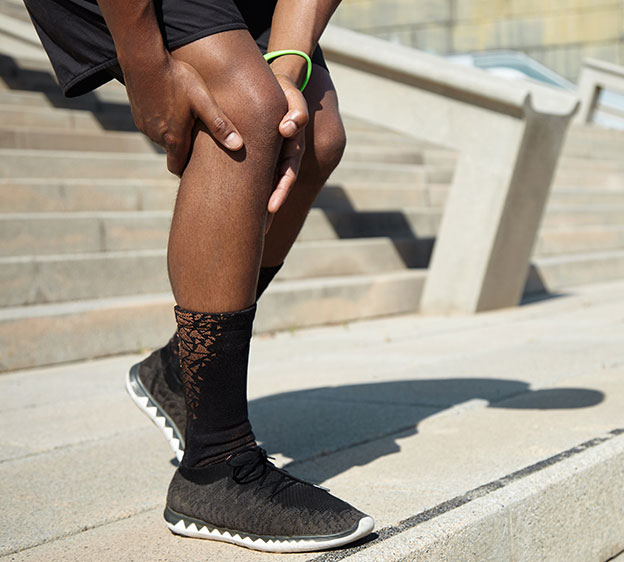
Taking the stairs burns calories and helps boost muscle strength, but it can also be tough on your knees. Knee pain going down stairs can be from a loss of cartilage in the knee joint to injuries to the soft tissues that help the knee function. Let’s explore some of these causes, what you can do to reduce pain at home and when it may be time to see an orthopedic specialist.
When Knee Pain Going Down Stairs Is Front and Center
When you descend stairs, your knees bear a lot of extra force, and the stress increases if you carry extra body weight. On top of this natural pressure, if you have a medical condition or injury affecting the knees, especially a loss of bone-cushioning cartilage, repeatedly bending the joints while taking the stairs can be painful.
Knee pain from going down stairs can spring from different parts of the joint. For many people, the source of discomfort is the area around the kneecap.
“When I ask patients to describe their symptoms, they often talk about pain in the front of the knee,” says Dr. Vandit Sardana, a board-certified, fellowship-trained orthopedic surgeon at Beaufort Memorial Orthopaedic Specialists. “This is anterior knee pain, and it often occurs from sports- or work-related overuse. Runners, for example, may feel knee pain going down stairs or during other activities after increasing their mileage too quickly.”
Pain from other parts of the knee can also flare when using stairs. Certain soft tissue injuries can cause pain on the outside of the knee (known as lateral knee pain) or the inside part of the joint (medial knee pain).
Read More: When Is the Right Time to Have Knee Replacement Surgery?
Runner’s Knee: A Major Cause of Knee Pain Going Down Stairs
When searching for the cause of knee pain, start by considering how much you use your knees. Repeated knee bending, whether by running every morning before work, squatting to reach low shelves or climbing stairs to your bedroom, can lead to runner’s knee. If you’re an avid exerciser, you’re more likely to develop runner’s knee if you ramp up your activity level too quickly or wear improper or worn-out shoes.
Also known as patellofemoral pain syndrome, runner’s knee can occur when the tissues and bones in the front of the knee cause pain. In some cases, loss of cartilage beneath the kneecap, which is known as chondromalacia patella, leading to inflammation and causing pain.
In addition to discomfort when taking the stairs, runner’s knee can cause:
- Pain after sitting for a prolonged period of time
- Pain when running, jumping or bending down
- Snapping or popping in your knee when you stand up or climb stairs
Read More: Safety on the Run: Tips to Prevent Running Injuries
Bad Connection: Knee Pain Due to IT Band Syndrome
Are you dealing with knee pain on the outside of the joint instead of around the kneecap? This could be a sign of iliotibial (IT) band syndrome, which is the irritation of a tendon (the IT band) that connects your pelvic bone and an area near the base of your knee.
“Overuse is a common cause of IT band syndrome,” Dr. Sardana says. “Repeated bending of the knee can cause the bursa, a fluid-filled sac separating the IT band and bone, to swell and hurt. The tendon itself can also become painful.”
With early IT band syndrome, you may have knee pain when walking as you warm up before exercise, but it may fade as the activity continues. Over time, however, the discomfort won’t go away during activity. You may also experience knee pain when climbing or descending stairs or while sitting.
Read More: Aching for Knee Pain Relief? Try These Home Remedies
When Knee Osteoarthritis Takes Out Cartilage
Another common cause of knee pain going down stairs, osteoarthritis removes the protective barriers between bones.
“Over time, the cartilage cushion in our knees wears down,” Dr. Sardana says. “When it’s gone, there’s nothing left to stop bones from rubbing against each other and forming painful growths called bone spurs. As cartilage diminishes, bending your knee to go up or down stairs or do other daily activities may get more and more difficult.”
Symptoms of osteoarthritis include:
- Clicking or grinding noises in your knee
- Knee stiffness
- Pain that worsens during or after intense exercise or with changes in the weather
- Swelling of the knee
Read More: Strengthen Your Quads to Improve Knee Osteoarthritis
Soothing a Sore Knee
Whether you first notice knee pain when walking to the mailbox or going down stairs, don’t just attempt to push through it. Pain is a message — your knee is telling you there’s a problem — and if you act on the warning quickly, you may be able to reduce or stop the hurt without needing medical care.
“The first rule of self-care for knee pain is the simplest: stop or slow down whatever makes your knee hurt,” Dr. Sardana says. “Taking a break from running or any other activity that causes symptoms can give your knee time to recover.”
To reduce swelling, ice your knee for 15 minutes several times per day. Need extra support for an aching knee? Try wearing an elastic sleeve.
When to See an Orthopedic Specialist
If knee pain persists despite your best efforts at self-care, see an orthopedic specialist for recommendations on what to try next.
“We’ll start with the most conservative option that’s appropriate for you, such as physical therapy, an anti-inflammatory or a steroid injection in the knee,” Dr. Sardana says. “For many people, those treatments are enough to allow them to enjoy the activities they love without pain standing in the way.”
Knee pain can be persistent. If you’ve exhausted nonsurgical treatment options, total knee replacement at a dedicated center can help you (finally) solve the pain problem — and take the stairs without thinking twice about an aching knee.
Tired of knee pain being a drag on your quality of life? Request an appointment with a Beaufort Memorial orthopedic specialist to learn about treatment options that can offer relief.

